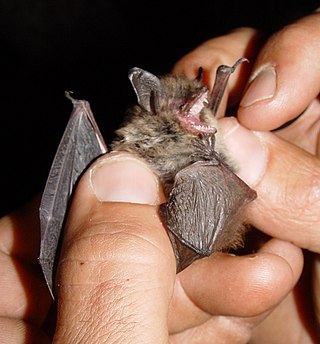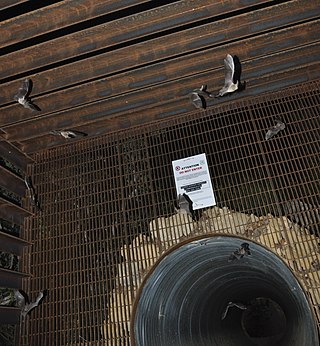
The mouse-eared bats or myotises are a diverse and widespread genus (Myotis) of bats within the family Vespertilionidae. The noun "myotis" itself is a Neo-Latin construction, from the Greek "muós and "oûs", literally translating to "mouse-eared".

The eastern long-fingered bat, or big-footed myotis is a species of vesper bat found in China, Japan, North Korea, South Korea, and Russia. Roosting in caves and rock crevices during the day, it forages at night for insects near rivers and streams.

Ikonnikov's bat is a species of vesper bat. An adult Ikonnikov's bat has a body length of 4.2-5.1 cm, a tail of 3.1-4.0 cm, and a wing length of 3.3-3.6 cm. It is found in eastern Siberia, the Ussuri region, Sakhalin, Hokkaido and Honshu (Japan), and the Korean Peninsula.

Myotinae is a subfamily of vesper bats. It contains three genera: Eudiscopus, Myotis, and Submyotodon. Before the description of Submyotodon and analysis of its phylogenetics, as well as a phylogenetic analysis of Eudiscopus, the only member of Myotinae was Myotis.

Daubenton's bat or Daubenton's myotis is a Eurasian bat with rather short ears. It ranges from Ireland to Japan (Hokkaido) and is considered to be increasing its numbers in many areas.

A maternity colony refers to a temporary association of reproductive female bats for giving birth to, nursing, and weaning their pups. The colonies are initiated by pregnant bats. After giving birth, the colony consists of the lactating females and their offspring. After weaning, juveniles will leave the maternity colony, and the colony itself will break apart. The size of a maternity colony is highly variable by species, with some species forming colonies consisting of ten or fewer individuals, while the largest maternity colony in the world in Bracken Cave is estimated to have over 15 million bats.

The long-tailed myotis is a species of vesper bat found in northern and eastern Asia.








